Glen Affric
| Glen Affric National Nature Reserve | |
|---|---|
|
IUCN category II (national park) | |
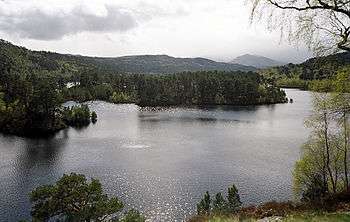 | |
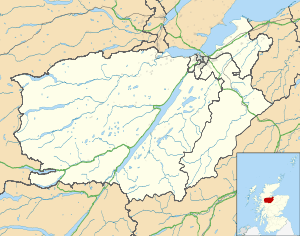 | |
| Location | Cannich, Highland, Scotland |
| Coordinates | 57°14′09″N 5°09′12″W / 57.23596°N 5.15327°WCoordinates: 57°14′09″N 5°09′12″W / 57.23596°N 5.15327°W |
| Area | 145 km2 (56 sq mi)[1] |
| Designation | Scottish Natural Heritage |
| Established | 2002[2] |
| Operator | Forestry Commission Scotland |
| Glen Affric National Nature Reserve | |
Glen Affric (Scottish Gaelic: Gleann Afraig) is a glen south-west of the village of Cannich in the Highland region of Scotland, some 15 miles (24 km) to the west of Loch Ness. The River Affric runs along its length, passing through Loch Affric and Loch Beinn a' Mheadhoin. A minor public road reaches as far as the end of Loch Beinn a' Mheadhoin, but beyond that point only rough tracks and footpaths continue along the glen.[3]
Often described as the most beautiful glen in Scotland, Glen Affric contains the third largest area of ancient Caledonian pinewoods in Scotland, as well as lochs, moorland and mountains.[4] The area is a Caledonian Forest Reserve,[5] a National Scenic Area and a National Nature Reserve.[6]
The forests and open landscapes of the glen, and the mountains on either side, are a popular destination for hikers, climbers and mountain bikers.[7]
Natural heritage
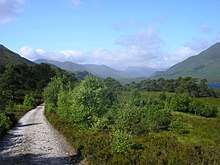
Glen Affric is listed in the Caledonian Pinewood Inventory,[5] and contains the third largest area of ancient Caledonian pinewoods in Scotland.[4] Due to the importance of this woodland it has been classified as a national nature reserve since 2002, [2] and is classified as a Category II protected area by the International Union for Conservation of Nature.[8] Scots pine trees first colonised the area after the last Ice Age 8-10,000 years ago.[9] Currently the oldest trees in the area are the gnarled "granny" pines that are the survivors from generations of felling by humans. Although felling ceased many years ago, regrowth had been hampered by unnaturally high populations of sheep and deer, and in the early 1950s the Forestry Commission found that very few of the remaining pines were less than 100 years old.[9] The main aim of management has therefore been to encourage regrowth of the pinewood by reducing deer numbers and by minimising the use of fencing[10] which can have negative impacts on black grouse and capercaillie who collide with the wires.[9]
Management of the reserve also seeks to remove non-native trees such as rhododendron.[11] Some commercial forestry (using faster growing non-native species such as sitka spruce) continues in order to maintain forest cover and to provide economic benefits to the local community.[11] The long term aim is to provide a network of forest habitats, with corridors of new forest linking existing woodland, interspersed with open areas. Management of the reserve also seeks to establish a 'treeline transition zone', in which there is a more gradual transition between woodland and mountain heath via a zone of shorter, more twisted trees and low-growing shrubs.[11] At western end of the glen the National Trust for Scotland are aiming to encourage the growth of other tree species such as birch and rowan to complement the pinewood.[12]
Following nearly seventy years of management to encourage restoration of the area, biodiversity has improved and Glen Affric now supports birds such as black grouse, capercaillie, ospreys and golden eagles. Glen Affric is also home to Scottish wildcats[9] and otters.[13] Much of the area forms part of a Special Protection Area for golden eagles,[14] and is also classified as a Special Area of Conservation.[13]
Glen Affric was proposed for inclusion in a national park by the Ramsay committee, set up following the Second World War to consider the issue of national parks in Scotland,[15] and in 2013 the Scottish Campaign for National Parks listed the area as one of seven deemed suitable for national park status,[16] however in September 2016 Roseanna Cunningham (Cabinet Secretary for Environment, Climate Change and Land Reform) told the Scottish Parliament that the Government had no plans to designate new national parks in Scotland and instead planned to focus on the two existing national parks.[17]
History
.jpg)
Glen Affric, also written Glenaffric,[18][19][20] was part of the lands of the Clan Chisholm and the Clan Fraser of Lovat from the 15th to the mid 19th centuries. By the early 15th century, Lord Lovat had passed the lands to his son Thomas who in turn passed it on to his son, William, who was recorded in Burke's Landed Gentry Scotland as William Fraser, first Laird of Guisachan.[21][22] The lands included regions that would become the Glen Affric deer park and the Guisachan Estate, including the village of Tomich.[23][24] In 1579, Thomas Chisholm, Laird of Strathglass, was imprisoned for being a Catholic.[25]
The Battle of Glen Affric took place in 1721
There exists in the Scottish Register of Tartans – possibly from the late 17th century – a "Glenaffric Fragment".[18]
By 1854, Dudley Marjoribanks, later Lord Tweedmouth, had acquired the lairdship of Glen Affric and Guisachan from Laird Fraser [26][27][28][29][30][31] whose family had built the original Guisachan Georgian manor house around 1755. By the 1860s, Lord Tweedmouth, as the new laird, had "much enlarged" the "laird's house",[32][33] using Scottish architect Alexander Reid who designed many buildings on Tweedmouth's vast Glen Affric Estate, including an entire village – Tomich – and the Glen Affric Hunting Lodge, described in appearance as "castle-like".[34] Tweedmouth had enjoyed a long lease on shooting rights over much of Glen Affric since 1846, and, following his acquisition of the lairdship, he initiated the first breed of golden retrievers at kennels near Guisachan House. He put the retrievers to good use at the shooting parties he hosted when at Glen Affric Lodge. The retrievers were sent to other estates when, for some months of the years 1870–71, he leased the Glen Affric Estate to Lord Grosvenor.[35][36][37][38][39][40][41]
Royal connections
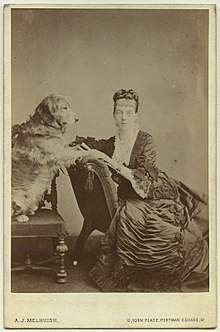
The Duke and Duchess of York are reported in The Graphic, 25 September 1897 to have visited the Guisachan Estate in Strathglass, including Glen Affric Lodge and deer park; "The Duchess, (later Queen Mary), driving around the estate with Lady Tweedmouth in 1897". The 2nd Baroness Tweedmouth was a "lover of the golden retriever dog" and was known and loved in the Highlands as the Lady of Glenaffric and Guisachan. She had been born Lady Fanny Spencer-Churchill, daughter of the 7th Duke of Marlborough. She died at Glen Affric Lodge in 1904.[42] The name of her nephew who came to her estate in 1901 was Winston Churchill, who amused himself learning how to drive a car in the grounds of this part of Glen Affric.[43][44][45][46][47]
Although Edward Marjoribanks, 2nd Baron Tweedmouth had inherited the lairdship of Glenaffric and Guisachan in 1894, the Clan Marjoribanks' ownership ended with Edward’s son, Dudley Churchill Marjoribanks, who became 3rd Lord Tweedmouth in 1909. He and his wife had two daughters, but no male heir. For the next few years, until 1918, the estate was owned by the family of Newton Wallop, 6th Earl of Portsmouth (1856–1917). Marmaduke Furness, 1st Viscount Furness owned the estate throughout the 1920s and 30s.[48][49] The entire property, then consisting of 22,000 acres (8,900 ha), had been sold by 1936 to a Mr Hunter. It was this laird that resold the Glen Affric deer forest to the west and a large area of grazing land to the Forestry Commission.[50][51][52][53]
Lady Islington acquired the Guisachan portion of the estate in 1939 but let the property go to ruin. In 1962 the Guisachan estate (now considerably reduced in size) was bought by a descendant of the Frasers of Gortuleg. In 1990, this later generation laird wrote a booklet concerning his Fraser ancestors who had once owned Guisachan – "Guisachan, A History by Donald Fraser".[36][54][55][56][57]
On 20 May 2017, the current heir to the courtesy title of Laird of Glen Affric, James Matthews, married Pippa Middleton, sister to Catherine, Duchess of Cambridge. The couple's wedding reception menu included locally themed Scottish produce: Glen Affric Cranachan Cheesecake and Affric Trail 10 year Highlands Malt.[58][59][60][61]
Ownership
Forestry Commission Scotland are the largest landowner, having owned most of the lower and central parts of the glen[62] (covering 17,604 ha)[63] since 1951.[2] The National Trust for Scotland have owned the 9,119 acres (3,690 ha)[64] West Affric Estate, which covers the upper part of the glen,[62] since 1993.[65]
The main private landowner is the North Affric Estate with its 8,974 acres (3,632 ha)[66] sporting estate taking in most of the land on the north side of Loch Affric.[62] The centerpiece of the estate is the Baronial castle[67] and associated deer park.[55] It was reported that, since 2008, the Glenaffric lairdship has been held by David Matthews.[24][50][68][69][70] Although the "castle-like" lodge is a private home for the Matthews family the estate is available to hire for those wishing to enjoy the "activities favoured by the noble elite"; trout fishing on Loch Affric, sailing, clay pigeon, target and game shooting, and deer stalking.[67][71][72][73][58]
The Guisachan area of Glen Affric, which lies to the south of the main glen, is also in private hands, now forming three separate estates. Wester Guisachan Estate covers the 9,342 acres (3,781 ha) to the south of Loch Affric,[74] whilst the Hilton & Guisachan Estates lies further east and covers 4,178 acres (1,691 ha).[75] The final portion of the Guisachan Estate, which remains in the ownership of the Fraser family, consists of 1,658 acres (671 ha) at the very east of the glen including the small settlement of Tomich.[76][77]
As with all land in Scotland, there is a right of responsible access to most of the land in the glen for pursuits such as walking, cycling, horse-riding and wild camping, regardless of whether the land is in public or private ownership.[78]
Tourism
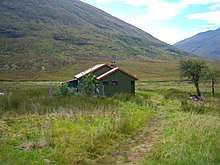
Glen Affric is popular with hillwalkers, as it provides access to many Munros and Corbetts. The north side of the glen forms a ridge with eight Munro summits, including the highest peak north of the Great Glen, Càrn Eige (1183 m).[79] The three Munros at the western end of this ridge, Sgùrr nan Ceathreamhnan (1151 m), Mullach na Dheireagain (982 m) and An Socach (921 m), are amongst some of the remotest hills in Scotland, and are often climbed from the Scottish Youth Hostels Association hostel at Alltbeithe.[79] The hostel is only open in the summer, and can only be reached by foot or by mountain bike via routes of between 10 and 13 km starting from lower down Glen Affric or from the A87 at Loch Cluanie or Morvich. The dormitories are unheated and hostellers are required to bring a sleeping bag, and to carry out all rubbish.[80] Glen Affric is also the starting point for routes to the summits of Munros to the south and west of the glen, although these can also be accessed from the Kintail area.[79] Corbetts accessible from Glen Affric include Sgùrr Gaorsaic, Càrn a' Choire Ghairbh and Aonach Shasuinn.[81]
The Affric Kintail Way is a 70 km long route from Drumnadrochit on the shore of Loch Ness to Morvich in Kintail via Glen Urquhart and Glen Affric. The route is suitable for both walkers and mountain bikers, and can usually be walked in four days.[82][83]
Shorter waymarked trails are provided in the lower parts of the glen, taking walkers to viewpoints and attractions such as the waterfalls at Plodda and the Dog Falls.[84]
Hydro-electric scheme
The glen is part of the Affric/Beauly hydroelectric scheme, constructed by the North of Scotland Hydro-Electric Board. Loch Mullardoch, in the neighbouring Glen Cannich, is dammed, and a 5 km tunnel carries water to Loch Beinn a' Mheadhoin, which has also been dammed. From there, another tunnel takes water to Fasnakyle power station, near Cannich. As the rivers in this scheme are important for Atlantic salmon, flow in the rivers is kept above agreed levels. The dam at Loch Beinn a' Mheadhoin has a Borland fish lifts to allow salmon to pass.[85]
References
- ↑ "Site Details for Glen Affric". Scottish Natural Heritage. 2018-03-05. Retrieved 2018-03-28.
- 1 2 3 "Glen Affric - Setting the Scene". Scottish Natural Heritage. 2016-07-13. Retrieved 2018-03-06.
- ↑ Ordnance Survey 1:50000 Landranger Sheet 25, Glen Carron and Glen Affric.
- 1 2 "The special qualities of the National Scenic Areas" (PDF). Scottish Natural Heritage. 2010. Retrieved 2018-03-06.
- 1 2 "Caledonian Pinewood Inventory". Forestry Commission Scotland. 2016-06-24. Retrieved 2018-02-28.
- ↑ "Sitelink - Map Search". Scottish Natural Heritage. Retrieved 2018-03-05.
- ↑ Humphreys, Rob; Reid, Donald (12 July 2012). The Great Glen Rough Guides Snapshot Scotland (includes Fort William, Glen Coe, Culloden, Inverness and Loch Ness). Rough Guides. pp. 25–. ISBN 978-1-4093-6581-5.
- ↑ "Glen Affric in United Kingdom of Great Britain and Northern Ireland". Protected Planet. Retrieved 2018-03-27.
- 1 2 3 4 "Glen Affric - Wood of Ages". Scottish Natural Heritage. 2014-11-18. Retrieved 2018-03-06.
- ↑ "Glen Affric - Managing for diversity". Scottish Natural Heritage. 2014-11-18. Retrieved 2018-03-06.
- 1 2 3 "Glen Affric - Return of the native". Scottish Natural Heritage. 2014-11-17. Retrieved 2018-03-06.
- ↑ "West Affric Estate". National Trust for Scotland. Retrieved 2018-03-06.
- 1 2 "Site Details for Strathglass Complex SAC". Scottish Natural Heritage. 2018-03-05. Retrieved 2018-03-06.
- ↑ "Site Details for Glen Affric to Strathconon SPA". Scottish Natural Heritage. 2018-03-05. Retrieved 2018-03-06.
- ↑ "History Leading to the Cairngorms National Park". Cairngorms National Park Authority. Retrieved 2018-01-15.
- ↑ "Unfinished Business a national parks strategy for scotland" (PDF). Scottish Campaign for National Parks. March 2013. Retrieved 2018-01-13.
- ↑ "Scottish Government "short sighted" over snub to national park for Galloway". Dumfries and Galloway - What's Going On. 2016-09-16. Retrieved 2018-01-13.
- 1 2 "Scottish Register of Tartans – Glenaffric Fragment". The Scottish Government – National Records of Scotland, H.M. General Register House. Retrieved 23 July 2016.
The information held within The Scottish Register of Tartans for the "Glenaffric Fragment" tartan is shown below....fragment appears to have been hand spun and hand woven. The piece has a hard surface, loose texture, and the use of combed yarn and a natural background is unlike the products of recent decades. It is similar to samples recovered from burials in peat – late 17th century. The dye used in the red stripe is not madder. The black stripe used iron mordant to a standard recipe. The green contains indigotin. Scottish Tartans Society archive.
- ↑ "A couple outside the Glenaffric Hotel, Cannich – (Ambaile – Highland History and Culture)". Highland Photographic Archive (IMAG). Retrieved 13 August 2014.
Couple outside the Glenaffric Hotel at Cannich...
- ↑ Coleridge, Nicholas (31 July 2012). How I Met My Wife. Random House. p. iii. ISBN 978-1448149896. Retrieved 23 July 2015.
But her misgivings have been completely satisfied by the Dowager Lady Glenaffric.....But now she's gone to Scotland actually.
- ↑ "Burke's Landed Gentry Scotland". Burke’s Peerage. Retrieved 13 August 2014.
(Page 954)...William Fraser – (Laird) of Guisachan and had....
- ↑ "Welcome to the Friends of Guisachan". Friends of Guisachan. Retrieved 4 August 2015.
First, it is the Scottish Highland lands dating back to the 14th century owned by Lord Lovat and then passed along to his son Thomas who in turn passed it on to his son William known as William Fraser, first of Guisachan. The clan history and the passage of the property through several families is well documented in the book Guisachan: A History by Donald Fraser, a Fraser clan descendent. It was first published in 1990 and it is sold by Golden Retriever Clubs throughout the world.
- ↑ "The Clan Chisholm". glenaffric.org. 2011. Retrieved 26 January 2015.
Glen Affric was part of the Clan Chisholm lands from the 15th to the mid 19th centuries
- 1 2 Gibson, Rob (2014). Highland Cowboys: From the Hills of Scotland to the American Wild West. Luath Press Ltd. pp. Maps. ISBN 9781909912960.
- ↑ "Our Lady and St Bean's Church, Marydale – Strathglass 'Pestered With Popery' & Knockfin". Parish of St Mary, Beauly. Retrieved 26 January 2014.
- ↑ Preston, Richard. "Tree Climbing in Scotland: The Forest in the Sky". National Geographic Society. Archived from the original on 31 May 2015. Retrieved 3 February 2016.
Lord Tweedmouth, a wealthy laird, bred the first golden retrievers..
- ↑ "Transactions of the Gaelic Society of Inverness, Volume 54". Inverness Gaelic Society - 1987. Retrieved 1 September 2018.
.. (he) first rented and then, as Lord Tweedmouth, bought Guisachan and the whole of Knockfin and Glenaffric.
- ↑ "GLASGOW NATURAL HISTORY SOCIETY NEWSLETTER" (PDF). GLASGOW NATURAL HISTORY SOCIETY NEWSLETTER - February 2013. p. 6. Retrieved 1 September 2018.
Most of these exotic trees were planted by Lord Tweedmouth who bought the Glen Affric Estate from Clan Chisholm in the mid 19th Century.
- ↑ "Glen Affric Lodge., Tomich". British Listed Buildings. Retrieved 3 February 2015.
A & W Reid, Elgin 1871. 2-storey asymmetrical gabled shooting lodge with Scottish Baronial detailing...Named Glen Affric Lodge in 1871. Built for Lord Tweedmouth (Laird) of (Glen Affric and) Guisachan.
- ↑ "Welcome to Glen Affric - Lord Tweedmouth" (PDF). Forestry Commission Scotland. Retrieved 1 September 2018.
Lord Tweedmouth bought Glen Affric estate from Clan Chisholm in the mid 1800s...
- ↑ "Glen Affric Guide" (PDF). Forestry Commission Scotland. Archived from the original (PDF) on 20 October 2016. Retrieved 26 July 2015.
Lord Tweedmouth bought (the) estate from Laird Fraser...
- ↑ "DSA Building/Design Report – Guisachan House". Dictionary of Scottish Architects. 2016. Retrieved 28 August 2013.
- ↑ "DSA Building/Design Report – Alexander Reid – Glen Affric Lodge". Dictionary of Scottish Architects. 2016. Retrieved 28 August 2013.
- ↑ Campbell, Kieran (29 October 2014). "Inside world's most exclusive holiday retreats – (Glen Affric Estate)". The Australian.
Staying in the castle-like lodge, you have available to you all activities favoured by the noble elite, including trout fishing on Loch Affric, sailing, clay pigeon shooting, target shooting and game shooting.
- ↑ "Highlands' own little piece of Eden". The Scotsman. 8 January 2012. Retrieved 26 January 2016.
The building itself was originally constructed as a hunting lodge by Sir Dudley Coutts Marjoribanks, the first Lord Tweedmouth, a Liberal MP, reputed to have bred the first golden retrievers there. It was bought by the Matthews family in 2008
- 1 2 "Strathglass". glenaffric.org. 2011. Retrieved 26 January 2016.
- ↑ "Burke's Landed Gentry Scotland". Burke’s Peerage. Retrieved 13 August 2014.
(Page 954)...William Fraser – (Laird) of Guisachan and had....
- ↑ "DSA Building/Design Report – Guisachan House". Dictionary of Scottish Architects. 2016. Retrieved 28 August 2013.
- ↑ "DSA Building/Design Report – Alexander Reid – Glen Affric Lodge". Dictionary of Scottish Architects. 2016. Retrieved 28 August 2013.
- ↑ "Lairds". Forestry Commission Scotland. 2016. Retrieved 28 August 2014.
Lairds – The lairds who controlled how land was managed in Affric have had a major influence on the look and life of the place.....Later, shooting became a fashionable sport – and one for which fashionable people would pay good money. Sir Dudley Coutts Marjoribanks, the first Lord Tweedmouth, was a rich Liberal MP who took a long lease on shooting rights over much of Glen Affric in 1846, paying £3,000 per year for the privilege: about £130,000 in today’s money.
- ↑ Morphet, M. N. (2011). "Golden Retrievers ~ Research Into the First Century in the Show Ring" (PDF). Tweedsmouth Publishing. pp. 62–3. Retrieved 17 July 2017.
1870–71 –(Glen) Affaric was leased to Lord Grosvenor at 500 pounds from 12th September...Some of the Retrievers are sent to (his) Aultleath (estate)
- ↑ Mack, Ann (17 May 2017). "History repeats itself with the two Lady Glen Affrics". Press and Journal. Retrieved 15 July 2017.
When she died at Glen Affric Lodge in 1904, it was reported that Fanny Spencer-Churchill was “known and loved as Lady Glen Affric by the Highlands people”.
- ↑ Strong-Boag, Veronica (2015). Liberal Hearts and Coronets: The Lives and Times of Ishbel Marjoribanks Gordon and John Campbell Gordon, the Aberdeens. University of Toronto Press. Retrieved 4 August 2016.
Page 56 ...(Fanny, while remaining "queenly" as the laird's wife) had won the love of Highland tenants on Marjoribanks estates – Glenaffric and Guisachan – further legitamising aristocratic authority.
- ↑ "Fanny Octavia Louisa (née Spencer-Churchill), Lady Tweedmouth with her golden retriever Crocus". London: National Portrait Gallery. 2016. Retrieved 13 August 2014.
A lover of the golden retriever dog, Fanny – Baroness Tweedmouth – was known in the Highland region of Scotland as the Lady of Glenaffric and Guisachan.
- ↑ Weir, Tom (2016). Tom Weir – Men of the Trees. The Scots Magazine. Retrieved 26 July 2016.
A Glen With Connections: Fate, however, had something in store for a young man who came here to visit his aunt, wife of the second Lord Tweedmouth. Her name was Lady Fanny Spencer Churchill, and the name of her nephew who came in 1901 was Winston, who amused himself learning how to drive a car in these grounds.
- ↑ Long, Phil; Palmer, Nicola J. (2008). Royal Tourism: Excursions Around Monarchy. Channel View Publications. p. 76. ISBN 9781845410803.
- ↑ Kelly, Guy (9 April 2017). "Meet the new Middleton marriage tribe: Who are Pippa's new in-laws?". Fairfax New Zealand Limited – The UK Daily Telegraph. Retrieved 15 July 2017.
The couple added to their portfolio in 2008 with the purchase of Glen Affric, a Victorian lodge and estate just north of Loch Ness, which is beloved of its esteemed guests: in 1897, the Duke and Duchess of York, later George V and Queen Mary, are reported to have visited, while a teenage Winston Churchill learnt to drive on its private roads.
- ↑ Pearson, H. (27 February 2018). The Marrying Americans. Pickle Partners Publishing. ISBN 9781787209572. Retrieved 21 August 2018.
...she accepted an invitation to stay at Glen Affric, his (Lord Furness's) shooting lodge ...where she managed to make friends with his daughter Averill, aged seventeen (at the time, i.e. 1925)...
- ↑ "Article". The Sphere London, England - 27 August 1932. Retrieved 4 August 2017.
Far the best stalking is in the Western Highlands though Strathconon is a notable exception. Glen Affric, which Lord Furness has sub-let for the last two years (1931-32), is another very fine deer forest.
- 1 2 Rutland, Tom; Rutland, Sarah. "Breed History – The Day We Met Dileas". Golden Retriever Club of America. Retrieved 3 February 2015.
- ↑ Pepper, Jeffrey G. (2012). Golden Retriever. i5 Publishing. p. 27. ISBN 9781621870340.
- ↑ "Article". The Sphere London, England - 27 August 1932. Retrieved 4 August 2017.
Far the best stalking is in the Western Highlands though Strathconon is a notable exception. Glen Affric, which Lord Furness has sub-let for the last two years, is another very fine deer forest.
- ↑ "An important polychrome and parcel gilt decorated oblique strung upright Exhibition Pianoforte by Wright and Mansfield, circa 1860". Bonhams 2016. Retrieved 13 August 2015.
The Earl and Countess of Portsmouth and the purchase of Guisachan. Newton Wallop (1856–1917) became 6th earl of Portsmouth in 1891. He was a member of parliament from 1880 to 1891 and under secretary of state for war from 1905 to 1908. He married Beatrice Mary in 1885, daughter of Mr Edward Pease. In 1905 the Earl bought Guisachan House and its estate from Lord Tweedmouth’s son Edward, who had inherited the house on his father’s death in 1894....When the 6th Earl died in 1917, (the estate) was put on the market
- ↑ "The Frasers of Guisachan". Bernard Poulin & Bernard Poulin. Archived from the original on 4 February 2016. Retrieved 26 January 2016.
- 1 2 "Glen Affric, In a Nutshell". böetic. Retrieved 26 January 2016.
- ↑ Fraser, Donald. "Guisachan – A History by Donald Fraser". Retrieved 26 July 2016.
- ↑ "Welcome to the Friends of Guisachan". Friends of Guisachan. Retrieved 4 August 2015.
- 1 2 Tamplin, Harley (22 August 2016). "Pippa's going to get a brand new title when she gets married". Metro. Retrieved 13 August 2016.
One day, the younger sister of the Duchess of Cambridge will inherit the title of Lady Glen Affric and will own a 10,000 acre estate that includes a castle.
- ↑ "Pampered Pippa's Over-The-Top Honeymoon". Woman's Day New Zealand. 29 May 2017. Retrieved 6 August 2017.
- ↑ "Prince Harry's menu card from Pippa Middleton's wedding up for sale!". Royal Life News. 2017. Retrieved 6 August 2017.
Dessert was a Glen Affric cranachan cheesecake, accompanied by a Highland whiskey honey – a clear nod to James’s family ties to Scotland. The drinks menu featured... Affric Trait 10 year Highlands Malt.
- ↑ Bonner, Mehera (19 May 2017). "Pippa Middleton's Official (and Surprising) Wedding Theme". Marie Claire - Hearst Communications, Inc. Retrieved 6 August 2017.
...chowing down on haggis canapés and lamb from the Glen Affric region of Scotland, and will also be drinking local whiskey...
- 1 2 3 "Property Search". Who Owns Scotland. Retrieved 2018-03-05.
- ↑ "Restoring native woodland in Glen Affr". Forestry Commission Scotland. 2016. Retrieved 2018-03-17.
- ↑ "Property Page: West Affric Estate". Who Owns Scotland. Retrieved 2018-03-17.
- ↑ National Trust for Scotland 2017 Guide, p. 97.
- ↑ "Property Page: North Affric Estate". Who Owns Scotland. Retrieved 2018-03-17.
- 1 2 Campbell, Kieran (29 October 2014). "Inside world's most exclusive holiday retreats – Glen Affric Estate". The Australian.
Staying in the castle-like lodge, you have available to you all activities favoured by the noble elite, including trout fishing on Loch Affric, sailing, clay pigeon shooting, target shooting and game shooting.
- ↑ "Forestry Commission Scotland".
The lairds who controlled how land was managed in Affric have had a major influence on the look and life of the place..The Chisholm clan's attempts to sell off the glen's rich timber seem to have had little success...Later, shooting became a fashionable sport – and one for which fashionable people would pay good money. Sir Dudley Coutts Marjoribanks, the first Lord Tweedmouth, was a rich Liberal MP who took a long leasehold on shooting rights over much of Glen Affric in 1846, paying £3,000 per year for the privilege: about £130,000 in today's money...He (Lord Tweedmouth) liked the place so much he later bought the estate at Guisachan (Gaelic for 'the place of the pines'), near Plodda Falls. He built a new mansion house there, as well as a hunting lodge (the baronial-castle Glen Affric Lodge) in Glen Affric itself for the weekends...Lord Tweedmouth's love for the glen didn't stop at building fancy houses for himself: he created a whole village at Tomich for the people living in cottages scattered across the (his) estate...the Forestry Commission bought (much of) the glen in 1951...
- ↑ Ryan, Jennifer (1 August 2013). "Sport: Stalking His Claim". Curtco Robb Media. Retrieved 26 January 2016.
David Matthews, an entrepreneur who has been hunting wild red deer in the majestic northern hills of Glen Affric for ...
- ↑ Gutteridge, Nick (20 July 2016). "Middleton of the Glen! How Pippa will get a title to rival her sister Kate after engagement". Daily Express. UK. Retrieved 21 July 2016.
...following her engagement to the son of a Scottish Laird.. who own(s) this huge baronial castle...Mr Matthews is the son of David Matthews, the Laird of Glen Affric.... bought the 10,000-acre estate in 2008....The 32-year-old sister of the Duchess of Cambridge will one day become Lady Glenaffric and have access to a sprawling 10,000-acre Scottish estate....Pippa will be able to use the courtesy title...bestowed on her as the heir's wife
- ↑ "The Nitty Gritty". The Glen Affric Estate. Retrieved 24 January 2016.
- ↑ Turbett, Liam (25 October 2014). "David Beckham's Haig Club whisky is exactly what's wrong with the Highlands". The UK Independent. Retrieved 24 January 2016.
The Glen Affric estate itself was purchased in 2008 by the Matthews family, owners of the exclusive Eden Rock hotel in the Caribbean and the parents of Made in Chelsea professional posh boy Spencer Matthews.
- ↑ Robbins, Tom (10 May 2013). "The Eden Rock, the luxury hotel on the French Caribbean island of Saint Barthélemy, has launched an outpost in Scotland". The Financial Times Ltd. Retrieved 24 January 2016.
Glen Affric, a Victorian manor on the shores of Loch Affric... a private home of the Matthews family, the owners of Eden Rock,...
- ↑ "Property Page: Wester Guisachan Estate". Who Owns Scotland. Retrieved 2018-03-18.
- ↑ "Property Page: Hilton & Guisachan Estate". Who Owns Scotland. Retrieved 2018-03-18.
- ↑ "Property Page: Guisachan Farm". Who Owns Scotland. Retrieved 2018-03-18.
- ↑ "Guisachan History". Tomich Holidays. Retrieved 2018-03-18.
- ↑ "Scottish Outdoor Access Code" (PDF). Scottish Natural Heritage. 2005. Retrieved 2018-01-16.
- 1 2 3 D. Bennet & R. Anderson. The Munros: Scottish Mountaineering Club Hillwalkers Guide, pp. 178-195. Published 2016.
- ↑ "Glen Affric Youth Hostel". Scottish Youth Hostels Association. Retrieved 2018-03-06.
- ↑ R. Milne & H Brown. The Corbetts and Other Scottish Hills - Scottish Mountaineering Club Hillwalkers' Guide, pp. 182-185. Published 2002.
- ↑ "About The Affric Kintail Way". Strathglass Marketing Group. Retrieved 2018-03-06.
- ↑ "Route Overview". Strathglass Marketing Group. Retrieved 2018-03-06.
- ↑ "Glen Affric Map and Guide" (PDF). Forestry Commission Scotland. March 2017. Retrieved 2018-03-06.
- ↑ "Power From the Glens" (PDF). Scottish and Southern Energy. p. 12. Archived from the original (PDF) on 2007-10-18. Retrieved 2008-03-08.
External links
| Wikimedia Commons has media related to Glen Affric. |